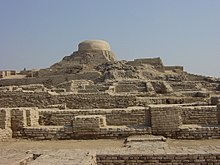Harappa (2600–1900 BC)
Harappa (2600–1900 BC)
This is a photo of a monument in Pakistan identified as the
Harappa (Punjabi pronunciation: [ɦəɽəppaː]; Urdu/Punjabi: ہڑپّہ) is an archaeological site in Punjab, Pakistan, about 24 km (15 mi) west of Sahiwal. The site takes its name from a modern village located near the former course of the Ravi River which now runs 8 km (5.0 mi) in north. The current village of Harappa is less than 1 km (0.62 mi) from the ancient site. Although modern Harappa has a legacy railway station from the period of the British Raj, it is today just a small crossroads town of population 15,000.
The site of the ancient city contains the ruins of a Bronze Age fortified city, which was part of the Indus Valley Civilization centered in Sindh and the Punjab, and then the Cemetery H culture.The city is believed to have had as many as 23,500 residents and occupied about 150 hectares (370 acres) with clay brick houses at its greatest extent during the Mature Harappan phase (2600–1900 BC), which is considered large for its time.Per archaeological convention of naming a previously unknown civilization by its first excavated site, the Indus Valley Civilization is also called the Harappan Civilization.The ancient city of Harappa was heavily damaged under British rule, when bricks from the ruins were used as track ballast in the construction of the Lahore–Multan Railway. In 2005, a controversial amusement park scheme at the site was abandoned when builders unearthed many archaeological artifacts during the early stages of building work. A plea from the Pakistani archaeologist Mohit Prem Kumar to the Ministry of Culture resulted in a restoration of the site.
History
Map showing the sites and extent of the Indus Valley Civilisation. Harappa was the center of one of the core regions of the Indus Valley Civilization, located in central Punjab. The Harappan architecture and Harappan Civilization was one of the most developed in the old Bronze Age.
The Harappan Civilization has its earliest roots in cultures such as that of Mehrgarh, approximately 6000 BC. The two greatest cities, Mohenjo-daro and Harappa, emerged circa 2600 BC along the Indus River valley in Punjab and Sindh.The civilization, with a possible writing system, urban centers, and diversified social and economic system, was rediscovered in the 1920s also after excavations at Mohenjo-daro in Sindh near Larkana, and Harappa, in west Punjab south of Lahore. A number of other sites stretching from the Himalayan foothills in east Punjab, India in the north, to Gujarat in the south and east, and to Pakistani Balochistan in the west have also been discovered and studied. Although the archaeological site at Harappa was damaged in 1857 when engineers constructing the Lahore-Multan railroad (as part of the Sind and Punjab Railway), used brick from the Harappa ruins for track ballast, an abundance of artifacts have nevertheless been found.The bricks discovered were made of red sand, clay, stones and were baked at very high temperature. As early as 1826 Harappa, located in west Punjab, attracted the attention of a British officer in India, who gets credit for preliminary excavations in Harappa.
Culture and economy
The Indus Valley civilization was mainly an urban culture sustained by surplus agricultural production and commerce, the latter including trade with Sumer in southern Mesopotamia. Both Mohenjo-Daro and Harappa are generally characterized as having "differentiated living quarters, flat-roofed brick houses, and fortified administrative or religious centers." Although such similarities have given rise to arguments for the existence of a standardized system of urban layout and planning, the similarities are largely due to the presence of a semi-orthogonal type of civic layout, and a comparison of the layouts of Mohenjo-Daro and Harappa shows that they are in fact, arranged in a quite dissimilar fashion.The weights and measures of the Indus Valley Civilization, on the other hand, were highly standardized, and conform to a set scale of gradations. Distinctive seals were used, among other applications, perhaps for identification of property and shipment of goods. Although copper and bronze were in use, iron was not yet employed. "Cotton was woven and dyed for clothing; wheat, rice, and a variety of vegetables and fruits were cultivated; and a number of animals, including the humped bull, were domesticated," as well as "fowl for fighting". Wheel-made pottery—some of it adorned with animal and geometric motifs—has been found in profusion at all the major Indus sites. A centralized administration for each city, though not the whole civilization, has been inferred from the revealed cultural uniformity; however, it remains uncertain whether authority lay with a commercial oligarchy. Harappans had many trade routes along the Indus River that went as far as the Persian Gulf, Mesopotamia, and Egypt. Some of the most valuable things traded were carnelian and lapis lazuli.
Archaeology
A map of the excavations at Harappa
Miniature Votive Images or Toy Models from Harappa, ca. 2500. Hand-modeled terra-cotta figurines with polychromy.
The excavators of the site have proposed the following chronology of Harappa's occupation:
Ravi Aspect of the Hakra phase, c. 3300 – 2800 BC.
Kot Dijian (Early Harappan) phase, c. 2800 – 2600 BC.
Harappan Phase, c. 2600 – 1900 BC.
Transitional Phase, c. 1900 – 1800 BC.
Late Harappan Phase, c. 1800 – 1300 BC.





























